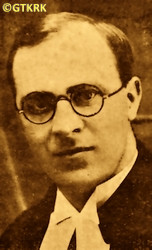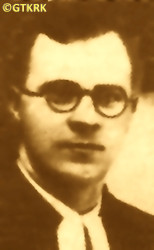Roman Catholic
St Sigismund parish
05-507 Słomczyn
85 Wiślana Str.
Konstancin deanery
Warsaw archdiocese, Poland
full list:
displayClick to display full list

searchClick to search full list by categories
wyświetlKliknij by wyświetlić pełną listę po polsku

szukajKliknij by przeszukać listę wg kategorii po polsku

Martyrology of the clergy — Poland
XX century (1914 – 1989)
personal data
surname
GUTKNECHT
forename(s)
Bruno (pl. Brunon)

function
pastor
creed
Evangelical Church of the Augsburg Confession in Poland EA
diocese / province
Płock seniority (commissariat)more on
en.wikipedia.org
[access: 2019.04.16]
nationality
German
date and place
of death
07.09.1939

Gąbintoday: Gąbin gm., Płock pov., Masovia voiv., Poland
more on
en.wikipedia.org
[access: 2021.12.18]
alt. dates and places
of death
08.09.1939, 03.09.1939
details of death
Before the outbreak of the World War II leader of local, Gąbin based Deutscher Volksverband — anti–Polish German party operating in Poland.
Opposed to Polish bishop Julius Bursche's policies.
Suspected by Poles of leading German clandestine diversionary saboteur bands.
After German invasion of Poland on 01.09.1939 and start of the World War II Polish authorities in Łódź captured in Łódź where often travelled a group of German saboteurs.
Then arrested in Gąbin by Polish authorities notified of Łódź arrests and suspicions surrounding him.
Sentenced by Polish military summary court and executed.
cause of death
execution
perpetrators
Poles
sites and events
Ribbentrop‐MolotovClick to display the description
date and place
of birth
31.01.1903

Łódźtoday: Łódź city pov., Łódź voiv., Poland
more on
en.wikipedia.org
[access: 2021.07.18]
presbyter (holy orders)
ordination
18.03.1928

positions held
1930 – 1939
parish priest — Gąbintoday: Gąbin gm., Płock pov., Masovia voiv., Poland
more on
en.wikipedia.org
[access: 2021.12.18] ⋄ EA parish — also: editor of „Evangelisch–Lutherischer Weichselbote” (pl. „Evangelical Lutheran Vistula Messenger”) newspaper
1928 – 1929
vicar — Warsawtoday: Warsaw city pov., Masovia voiv., Poland
more on
en.wikipedia.org
[access: 2021.10.09] ⋄ Holy Trinity EA parish
1926 – 1928
student — Erlangentoday: Erlangen urban dist., Middle Franconia reg., Bavaria state, Germany
more on
en.wikipedia.org
[access: 2023.03.24] ⋄ theology, Friedrich–Alexander–Universität (Eng. Friedrich–Alexander University)
1923 – 1926
student — Warsawtoday: Warsaw city pov., Masovia voiv., Poland
more on
en.wikipedia.org
[access: 2021.10.09] ⋄ Evangelical Theology Department, University of Warsaw [i.e. University of Warsaw (from 1945) / clandestine University (1939‐1945) / Joseph Piłsudski University (1935‐1939) / University of Warsaw (1915‐1935) / Imperial University of Warsaw (1870‐1915)]
others related
in death
BANSZELClick to display biography Charles, BIELIŃSKIClick to display biography Joseph, BURSCHEClick to display biography Edmund, BURSCHEClick to display biography Julius, FALZMANNClick to display biography Alexander Charles, FREYDEClick to display biography Alfred, GNIDAClick to display biography Francis, GUMPERTClick to display biography Steven Edward, GUTSCHClick to display biography Sigismund, HAUSEClick to display biography Paul Henry, KAHANEClick to display biography George, KOŻUSZNIKClick to display biography Stanislav, KULISZClick to display biography Charles, KUŹWAClick to display biography Sigismund, LEHMANNClick to display biography George, MAYClick to display biography Leo Witold, MAMICAClick to display biography Joseph, MANITIUSClick to display biography Gustav, NIEROSTEKClick to display biography Joseph, NITSCHMANNClick to display biography Adam Robert, OŻANAClick to display biography Gustav, PASZKOClick to display biography Richard, PAWLASClick to display biography Vladislav, WAGNERClick to display biography Richard Ernest, ZMEŁTYClick to display biography Adolph
sites and events
descriptions
Ribbentrop‐Molotov: Genocidal Russian‐German alliance pact between Russian leader Joseph Stalin and German leader Adolf Hitler signed on 23.08.1939 in Moscow by respective foreign ministers, Mr. Vyacheslav Molotov for Russia and Joachim von Ribbentrop for Germany. The pact sanctioned and was the direct cause of joint Russian and German invasion of Poland and the outbreak of the World War II in 09.1939. In a political sense, the pact was an attempt to restore the status quo ante before 1914, with one exception, namely the „commercial” exchange of the so‐called „Kingdom of Poland”, which in 1914 was part of the Russian Empire, fore Eastern Galicia (today's western Ukraine), in 1914 belonging to the Austro‐Hungarian Empire. Galicia, including Lviv, was to be taken over by the Russians, the „Kingdom of Poland” — under the name of the General Governorate — Germany. The resultant „war was one of the greatest calamities and dramas of humanity in history, for two atheistic and anti‐Christian ideologies — national and international socialism — rejected God and His fifth Decalogue commandment: Thou shall not kill!” (Abp Stanislav Gądecki, 01.09.2019). The decisions taken — backed up by the betrayal of the formal allies of Poland, France and Germany, which on 12.09.1939, at a joint conference in Abbeville, decided not to provide aid to attacked Poland and not to take military action against Germany (a clear breach of treaty obligations with Poland) — were on 28.09.1939 slightly altered and made more precise when a treaty on „German‐Russian boundaries and friendship” was agreed by the same murderous signatories. One of its findings was establishment of spheres of influence in Central and Eastern Europe and in consequence IV partition of Poland. In one of its secret annexes agreed, that: „the Signatories will not tolerate on its respective territories any Polish propaganda that affects the territory of the other Side. On their respective territories they will suppress all such propaganda and inform each other of the measures taken to accomplish it”. The agreements resulted in a series of meeting between two genocidal organization representing both sides — German Gestapo and Russian NKVD when coordination of efforts to exterminate Polish intelligentsia and Polish leading classes (in Germany called «Intelligenzaktion», in Russia took the form of Katyń massacres) where discussed. Resulted in deaths of hundreds of thousands of Polish intelligentsia, including thousands of priests presented here, and tens of millions of ordinary people,. The results of this Russian‐German pact lasted till 1989 and are still in evidence even today. (more on: en.wikipedia.orgClick to attempt to display webpage
[access: 2015.09.30])
sources
personal:
holland.org.plClick to attempt to display webpage
[access: 2015.09.30], eduardkneifel.euClick to attempt to display webpage
[access: 2023.03.24]
bibliographical:
„Płock diocese clergy martyrology during II World War 1939‐1945”, Fr Nicholas Marian Grzybowski, Włocławek–Płock 2002
original images:
docplayer.orgClick to attempt to display webpage
[access: 2023.03.24], www.facebook.comClick to attempt to display webpage
[access: 2023.03.24]
LETTER to CUSTODIAN/ADMINISTRATOR
If you have an Email client on your communicator/computer — such as Mozilla Thunderbird, Windows Mail or Microsoft Outlook, described at WikipediaPatrz:
en.wikipedia.org, among others — try the link below, please:
LETTER to CUSTODIAN/ADMINISTRATORClick and try to call your own Email client
If however you do not run such a client or the above link is not active please send an email to the Custodian/Administrator using your account — in your customary email/correspondence engine — at the following address:

giving the following as the subject:
MARTYROLOGY: GUTKNECHT Bruno
To return to the biography press below:
 Click to return to biography
Click to return to biography









